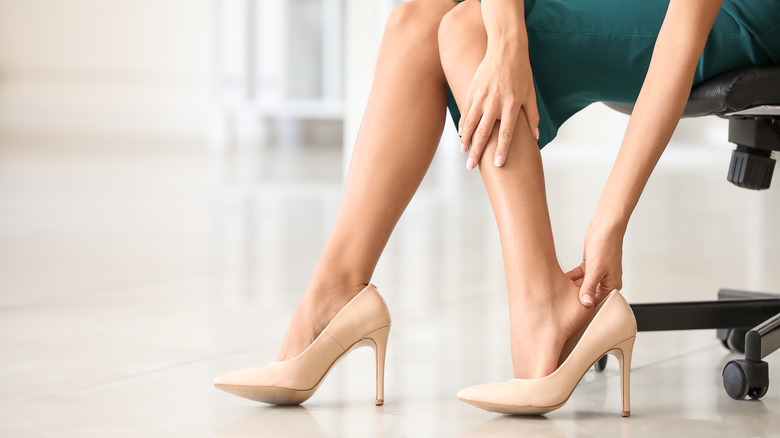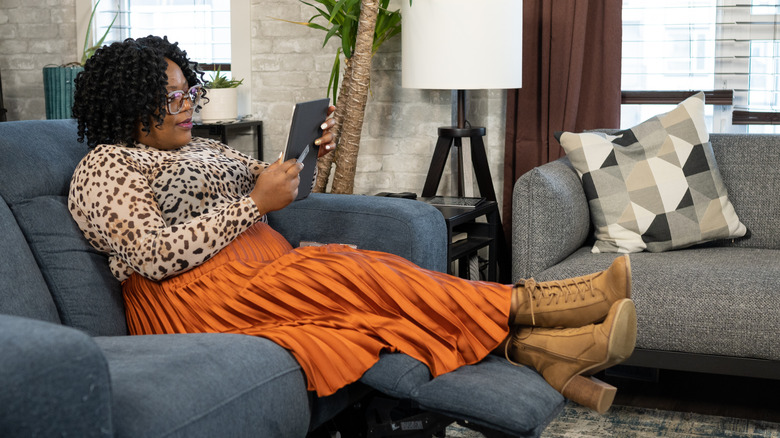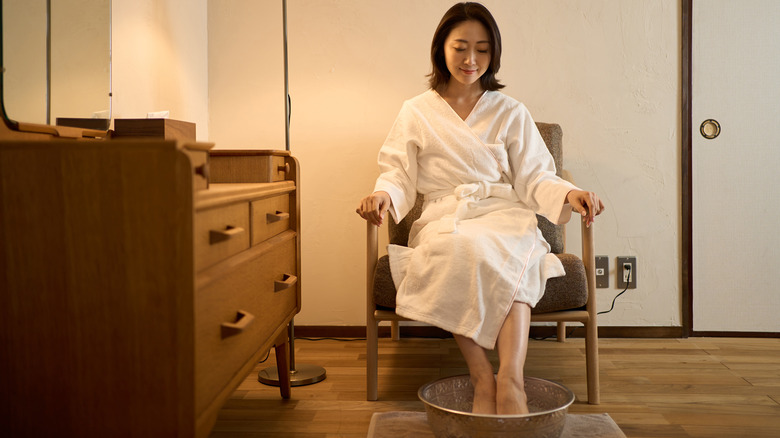Could Your Too-Tight Shoes Be Causing Ingrown Nails? Here's What To Know
Nothing ruins a fresh pedicure and baby soft feet quite like an ingrown toenail. According to Mayo Clinic, ingrown nails occur when part of the nail grows into the fleshy skin surrounding it. The big toe is the most likely spot to develop this pesky nail issue, though it can happen on any toe (and even on your fingers). Ingrown nails can be identified by their signature inflammation and swelling, and in some cases, you might also notice pus where the nail has become attached to the skin.
Clearly, ingrown toenails can be a (literal) pain to deal with, and prevention is a much easier way to handle the condition than treating it after it's already developed. While some health issues can increase your risk of getting ingrown nails, such as diabetes, the good news is that most prevention methods come down to simple lifestyle choices. The bad news: Your favorite super-snug shoes could be to blame. If you're suffering from ingrown nails, it might be time to toss your too-tight footwear once and for all.
The link between tight shoes and ingrown nails
Ingrown nails can form whenever the nail has an opportunity to grow into the flesh, rather than over it, and according to the American Academy of Orthopaedic Surgeons, the condition often develops when the nails are cut too short. So what does any of this have to do with your shoes? Essentially, tight shoes force the toes close together, leaving little room for the nails. This creates painful pressure that, with time, can lead to ingrown nails.
Besides squeezing the toes and nails together, some styles of ill-fitting footwear also tend to trap sweat. Cedars Sinai notes that this, too, can cause nail problems. Generally, clean and dry tootsies are less likely to develop ingrown nails, and more importantly, they're less likely to become infected.
Keep in mind that shoes aren't the only culprit when it comes to ingrown toenails. Tight, sweaty socks and hosiery can also be enough to encourage nail growth deformities, per WebMD.
Signs your shoes may be wrecking your toenails
If you keep getting ingrown nails, you might want to take an honest look at the way your footwear fits. "Your shoes should feel sturdy and comfortable and should fit both the length and width of your foot," leading podiatrist and founder of Osgo Healthcare Tony Gavin told Woman & Home. "Your toes should have room to be able to wiggle freely." If you can barely fit a finger inside or if there's no room in the toe cap (for close-toed shoes), the shoe is too tight.
Style, in addition to size, also matters. According to Capital Podiatry Associates, it's best to steer clear of footwear with a pointed toe to prevent ingrown nails. Opt for wider shoes with a rounded toe instead. Additionally, flat or low-heeled shoes are your friend. "Increased heel height transfers most of your body weight toward the front of the foot," Chief of Podiatry at Boston's Brigham and Women's Hospital Dr. James Ioli explained to Harvard Health. "The big toes are subjected to a lot of pressure and deforming forces over the years as a result of high heels, especially if you wear them consistently for a long period of time." That pressure can eventually be enough to trigger pesky ingrown toenails.
How to stretch out too-tight shoes
If your beloved ballet flats or favorite pair of preppy loafers are just a little too snug, you might be able to stretch them out to give your toes some much-needed space. One classic trick is the blow dryer method. Put on some thick socks, pull on your shoes, and blast the tight areas with a blow dryer to loosen them up. While you're at it, keep your shoes on in the house to help them conform to your feet without risking the pain and blisters associated with wearing footwear out before they're broken in.
A few handy products can also help stretch out small shoes. Look for adjustable shoe trees, or wooden blocks that can be inserted inside to shape your shoes. There are also sprays available that soften and potentially lengthen tight footwear (via The Strategist). Once there's enough space, consider adding a buffer to prevent ingrown toenails or avoid further irritation if you already have one. "[You can use] toe protectors to help separate the toe from hitting the shoes on one side and the adjacent digits on the other side," podiatrist Dr. Michael Galoyan suggested to MindBodyGreen.
Treatment for ingrown toenails
Switching to properly fitting shoes and socks is one of the best — and easiest — ways to prevent ingrown toenails. However, comfy footwear isn't enough to treat ingrown nails that have already developed. And as foot and ankle surgeon at The Centers for Advanced Orthopaedics Dr. Steven Neufeld shared with Insider, "An ingrown nail does not typically go away on its own. It will continue to grow into the surrounding skin and soft tissues unless treated."
Letting your nail grow into the skin might not seem like a big deal, but it can lead to worse problems down the line. "Many people believe that ingrown toenails simply cause discomfort. But they can be the cause of infections. This is why I recommend that you don't attempt to treat an ingrown toenail at home," podiatrist Dr. Velimir Petkov explained to Allure. Besides nipping inflammation with ibuprofen or a DIY Epsom salt bath, it's generally best to let the pros take care of your ingrown nails. A doctor can check for signs of infection and prescribe antibiotics if needed. A foot specialist may also remove part or all of the toenail, depending on the severity of the condition, per NHS.
Once you've treated your ingrown, commit to only wearing toe-friendly shoes. Otherwise, you might be right back in the doctor's office with another painful nail.




